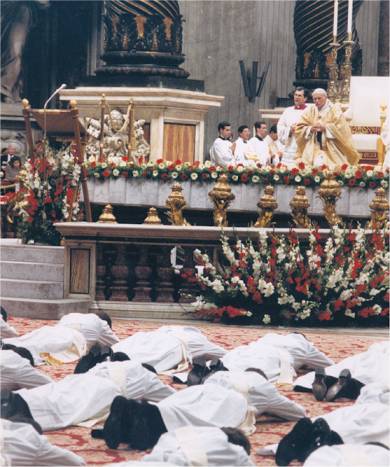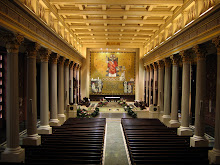My next submission to the Catholic Moment in the Catholic Telegraph, paper of record in the Archdiocese of Cincinnati:
In my last column, Melchizedek was upheld as the first model of priesthood in the Scriptures. This initial model was rather short lived, unfortunately. During the Exodus, the Tribe of Levi claimed the priestly responsibilities of the Jewish people. This shift proves pertinent for our ongoing discussion regarding the Year for Priests.
As the People of Israel moved out of Egypt, they were to sacrifice the animals that represented the gods of Egypt: goats, sheep and bulls. This was a time of purification so they could worship the One True God with clean hearts and souls. The purification, however, was long in coming, and as Moses was atop Mt. Sinai in conversation with The One Who Is, his older brother Aaron shaped the Golden Calf for the people to worship. Israel’s constant struggle with Idolatry, the worship of false gods, had finally born fruit; and God’s wrath was ablaze.
We pick up the story in Exodus 32 as Moses returns to the camp to rally “whoever is for the LORD.” The Levites rush to the aid of Moses, who then commissions them: "Thus says the LORD, the God of Israel: Put your sword on your hip, every one of you! Now go up and down the camp, from gate to gate, and slay your own kinsmen, your friends and neighbors!" The Levites carried out the command of Moses, and that day there fell about three thousand of the people. Then Moses said, "Today you have been dedicated to the LORD, for you were against your own sons and kinsmen, to bring a blessing upon yourselves this day." (Ex 32:27-29)
This seems like a very harsh treatment on God’s part against those who sinned, setting up the false dichotomy of this seemingly hard handed approach versus the image of a Loving God as presented in the New Testament.
At this time in history, God was working to purify and cleanse the people of Israel from the lasting effects of several hundred years in Egypt. When it comes to ritual and worship, He demands a purity of heart, as well as a purity of experience. When the leaders of the people, who should have known better, lead the people into sin, there must be an account to pay, and the Levites, with their zeal for serving the Lord before all else, gladly rise to the challenge. Dialogue is not the answer, purity and a quest for the Truth are. For the Levites, living according to God’s plan was more important than living, and such an extreme response might call their kinsmen to repentance.
Therefore, we start to realize that the main opposition that Jesus had against the Levitical priests in his day is that they have fallen from their original zeal in serving the LORD above all else. They placed a desire for prestige among men before the desire to serve God.
This initial zeal for the salvation of souls as exhibited by the Levites is what caused them to be selected and consecrated to serve the LORD exclusively. It is this same zeal for the salvation of souls which must be a constitutive aspect of the character of men studying for the priesthood today. The men in formation must put the desire for serving God above the desire for prestige and honor; for even though these come to the priest by virtue of his office, the question he will be asked upon his final judgment will more likely be along the line of: “How many souls did you save?”
This orientation towards salvation of souls is one that can be difficult to achieve, for Jesus promises that as He has been persecuted, so will those who follow Him. Yet, we all work to build a place in the Kingdom of Heaven. Let us all model and imitate the zeal of the Levites in striving for purity of heart in worship, and if the LORD is calling you to spend your life for the salvation of your brothers and sisters, visit www.cincinnativocations.org.
These are supposed to run at Catholic Exchange and on NCDVD.org as well, but I haven't seen them there, yet.
Subscribe to:
Post Comments (Atom)










1 comment:
Thanks, you just saved me 50 cents! Good article.
Post a Comment